Discover 35 hidden attractions, cool sights, and unusual things to do in Venice (Italy). Don't miss out on these must-see attractions: Piazza San Marco, Doge's Palace, and Santa Maria della Salute. Also, be sure to include Church of San Giorgio Maggiore in your itinerary.
Below, you can find the list of the most amazing places you should visit in Venice (Veneto).
Table of Contents
Piazza San Marco
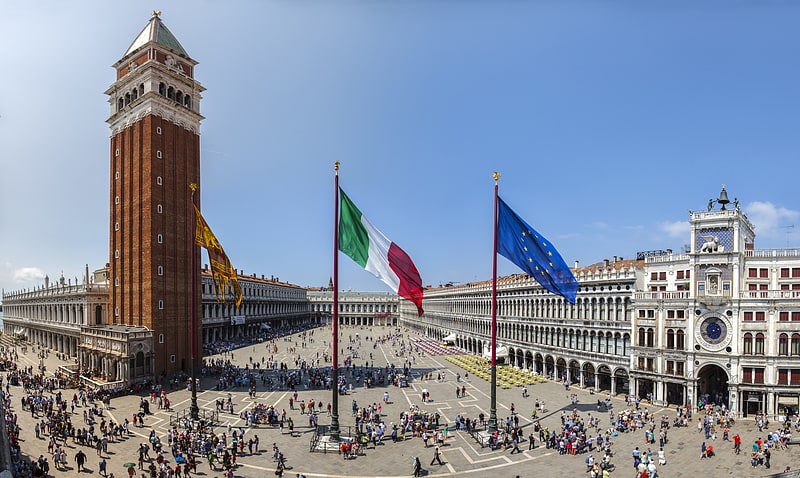
Plaza in Venice, Italy. Piazza San Marco, often known in English as St Mark's Square, is the principal public square of Venice, Italy, where it is generally known just as la Piazza. All other urban spaces in the city are called campi. The Piazzetta is an extension of the Piazza towards San Marco basin in its south east corner. The two spaces together form the social, religious and political centre of Venice and are commonly considered together. This article relates to both of them.
A remark usually attributed (though without proof) to Napoleon calls the Piazza San Marco "the drawing room of Europe".[1]
Address: Piazza San Marco, 30124 Venezia
Doge's Palace
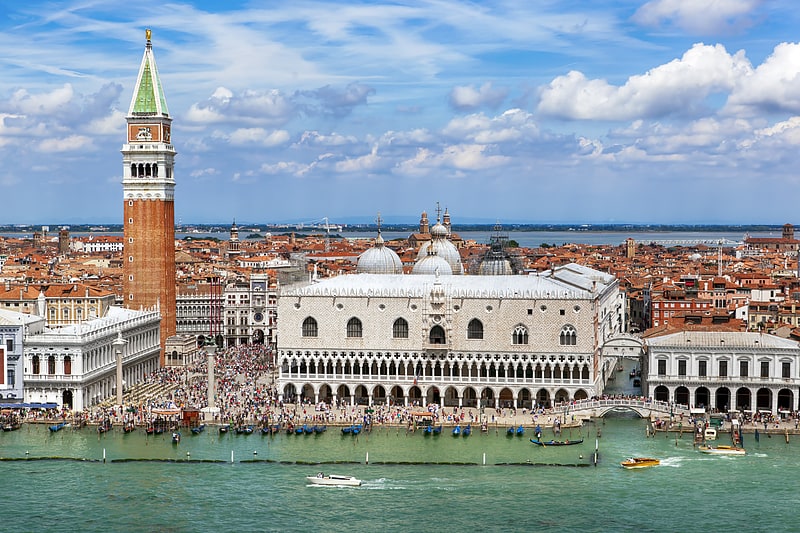
Also known as: Palazzo Ducale
Gothic-style palace and museum. The Doge's Palace is a palace built in Venetian Gothic style, and one of the main landmarks of the city of Venice in northern Italy. The palace was the residence of the Doge of Venice, the supreme authority of the former Republic. It was built in 1340 and extended and modified in the following centuries. It became a museum in 1923 and is one of the 11 museums run by the Fondazione Musei Civici di Venezia.[2]
Address: Piazza San Marco, 1, 30124 Venezia
Santa Maria della Salute
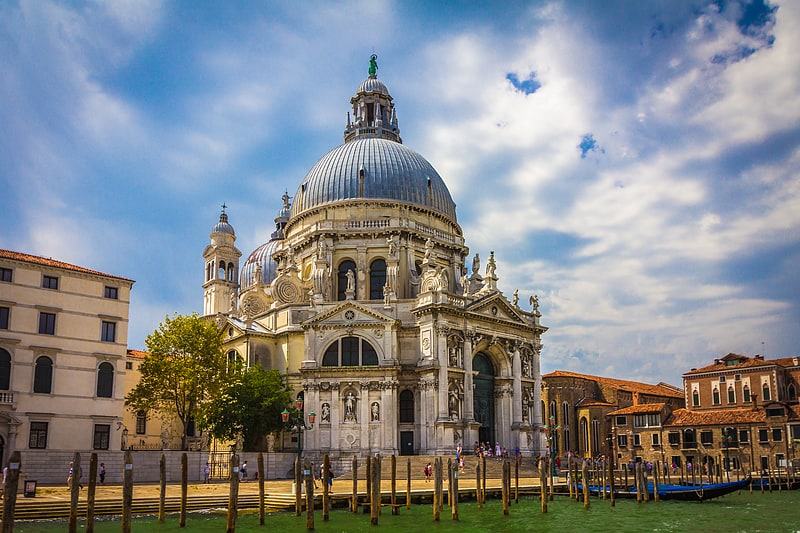
Iconic 1600s church with a vast cupola. Santa Maria della Salute, commonly known simply as the Salute, is a Roman Catholic church and minor basilica located at Punta della Dogana in the Dorsoduro sestiere of the city of Venice, Italy.
It stands on the narrow finger of Punta della Dogana, between the Grand Canal and the Giudecca Canal, at the Bacino di San Marco, making the church visible when entering the Piazza San Marco from the water. The Salute is part of the parish of the Gesuati and is the most recent of the so-called plague churches.
In 1630, Venice experienced an unusually devastating outbreak of the plague. As a votive offering for the city's deliverance from the pestilence, the Republic of Venice vowed to build and dedicate a church to Our Lady of Health. The church was designed in the then fashionable Baroque style by Baldassare Longhena, who studied under the architect Vincenzo Scamozzi. Construction began in 1631. Most of the objects of art housed in the church bear references to the Black Death.
The dome of the Salute was an important addition to the Venice skyline and soon became emblematic of the city, inspiring artists such as Canaletto, J. M. W. Turner, John Singer Sargent, and the Venetian artist Francesco Guardi.[3]
Address: Campo de la Salute Dorsoduro 1, 30123 Venice
Church of San Giorgio Maggiore
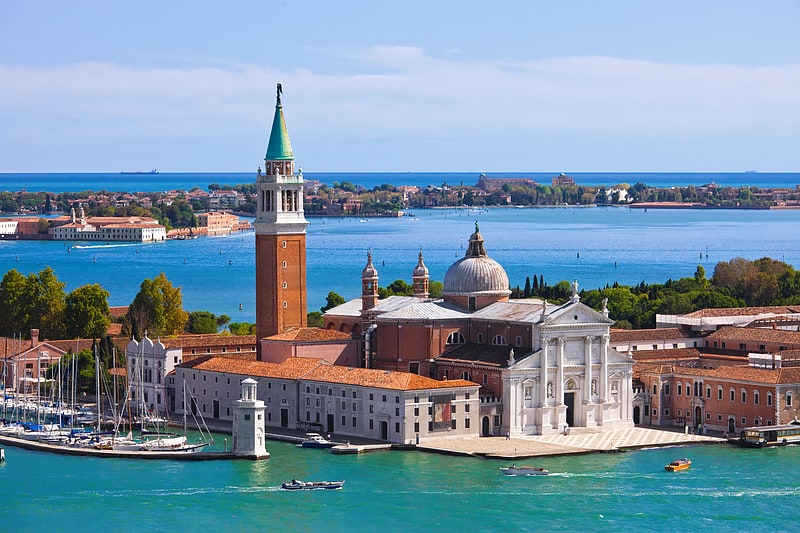
Also known as: Basilica di San Giorgio Maggiore
Palladian church overlooking the lagoon. San Giorgio Maggiore is a 16th-century Benedictine church on the island of the same name in Venice, northern Italy, designed by Andrea Palladio, and built between 1566 and 1610. The church is a basilica in the classical Renaissance style and its brilliant white marble gleams above the blue water of the lagoon opposite the Piazzetta di San Marco and forms the focal point of the view from every part of the Riva degli Schiavoni.[4]
Address: Isola di S.Giorgio Maggiore, 30133 Venezia, Venice
St Mark's Basilica
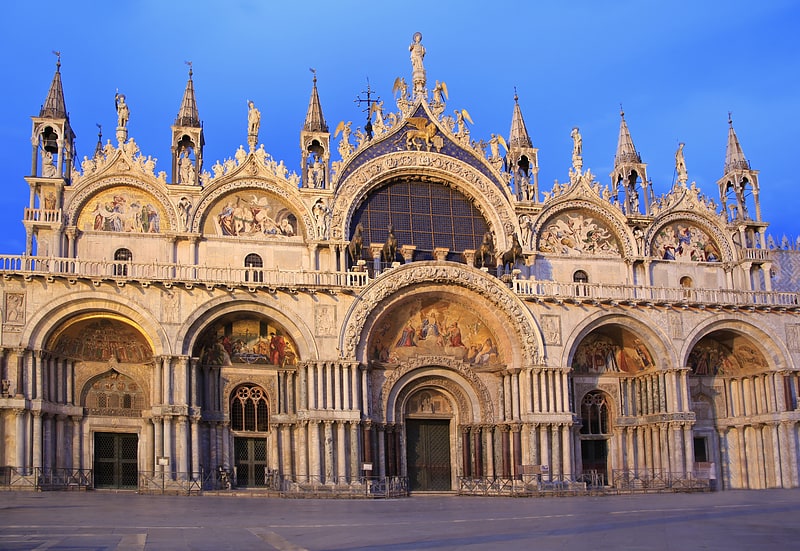
Also known as: Basilica di San Marco
Landmark cathedral with gilded domes. The Patriarchal Cathedral Basilica of Saint Mark, commonly known as St Mark's Basilica, is the cathedral church of the Roman Catholic Patriarchate of Venice; it became the episcopal seat of the Patriarch of Venice in 1807, replacing the earlier cathedral of San Pietro di Castello. It is dedicated to and holds the relics of Saint Mark the Evangelist, the patron saint of the city.
The church is located on the eastern end of Saint Mark's Square, the former political and religious centre of the Republic of Venice, and is attached to the Doge's Palace. Prior to the fall of the republic in 1797, it was the chapel of the Doge and was subject to his jurisdiction, with the concurrence of the procurators of Saint Mark de supra for administrative and financial affairs.
The present structure is the third church, begun probably in 1063 to express Venice's growing civic consciousness and pride. Like the two earlier churches, its model was the sixth-century Church of the Holy Apostles in Constantinople, although accommodations were made to adapt the design to the limitations of the physical site and to meet the specific needs of Venetian state ceremonies. Middle-Byzantine, Romanesque, and Islamic influences are also evident, and Gothic elements were later incorporated. To convey the republic's wealth and power, the original brick façades and interior walls were embellished over time with precious stones and rare marbles, primarily in the thirteenth century. Many of the columns, reliefs, and sculptures were spoils stripped from the churches, palaces, and public monuments of Constantinople as a result of the Venetian participation in the Fourth Crusade. Among the plundered artefacts brought back to Venice were the four ancient bronze horses that were placed prominently over the entry.
The interior of the domes, the vaults, and the upper walls were slowly covered with gold-ground mosaics depicting saints, prophets, and biblical scenes. Many of these mosaics were later retouched or remade as artistic tastes changed and damaged mosaics had to be replaced, such that the mosaics represent eight hundred years of artistic styles. Some of them derive from traditional Byzantine representations and are masterworks of Medieval art; others are based on preparatory drawings made by prominent Renaissance artists from Venice and Florence, including Paolo Veronese, Tintoretto, Titian, Paolo Uccello, and Andrea del Castagno.[5]
Address: Piazza San Marco, 328, 30124 Venezia
Horses of Saint Mark
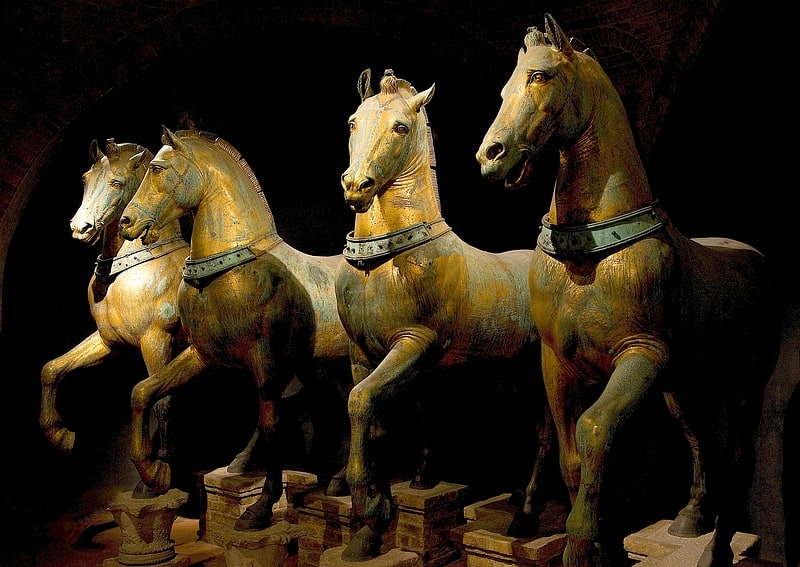
Also known as: Cavalli di San Marco
Statue by Lysippos. The Horses of Saint Mark, also known as the Triumphal Quadriga, is a set of bronze statues of four horses, originally part of a monument depicting a quadriga. The horses were placed on the facade, on the loggia above the porch, of St Mark's Basilica in Venice, northern Italy after the sack of Constantinople in 1204. They remained there until looted by Napoleon in 1797 but were returned in 1815. The sculptures have been removed from the facade and placed in the interior of St Mark's for conservation purposes, with replicas in their position on the loggia.[6]
Museo Correr
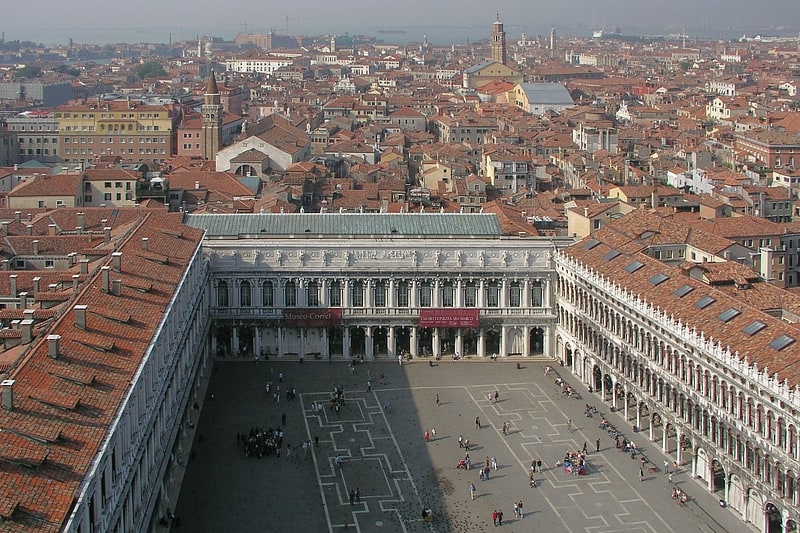
Museum of Venetian art and antiquities. The Museo Correr is a museum in Venice, northern Italy. Located in St. Mark's Square, Venice, it is one of the 11 civic museums run by the Fondazione Musei Civici di Venezia. The museum extends along the southside of the square on the upper floors of the Procuratorie Nuove. With its rich and varied collections, the Museo Correr covers both the art and history of Venice.[7]
Address: Piazza San Marco, 52, 30124 Venezia
Peggy Guggenheim Collection
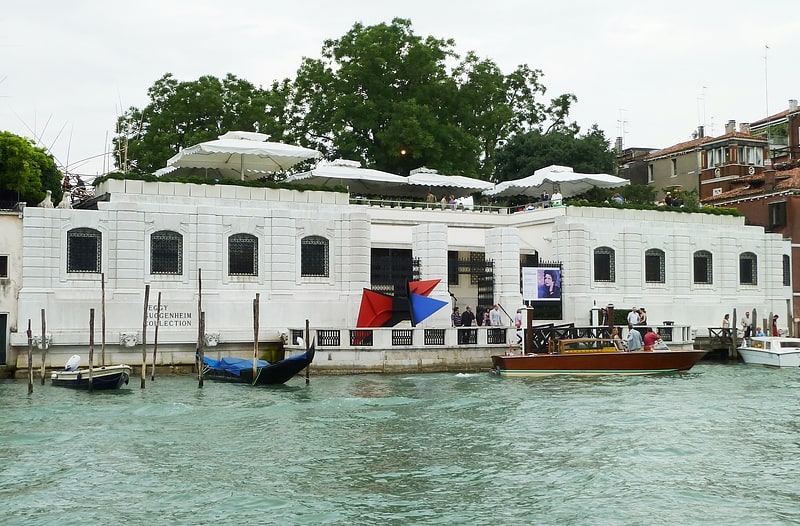
Modern art museum in 18th-century palace. The Peggy Guggenheim Collection is a modern art museum on the Grand Canal in the Dorsoduro sestiere of Venice, Italy. It is one of the most visited attractions in Venice. The collection is housed in the Palazzo Venier dei Leoni, an 18th-century palace, which was the home of the American heiress Peggy Guggenheim for three decades. She began displaying her private collection of modern artworks to the public seasonally in 1951. After her death in 1979, it passed to the Solomon R. Guggenheim Foundation, which opened the collection year-round from 1980.
The collection includes works of prominent Italian futurists and American modernists working in such genres as Cubism, Surrealism and abstract expressionism. It also includes sculptural works. In 2017, Karole Vail, a granddaughter of Peggy Guggenheim, was appointed Director of the collection, succeeding Philip Rylands, who led the museum for 37 years.[8]
Address: Dorsoduro, 701-704, 30123 Venezia
Santa Maria Gloriosa dei Frari
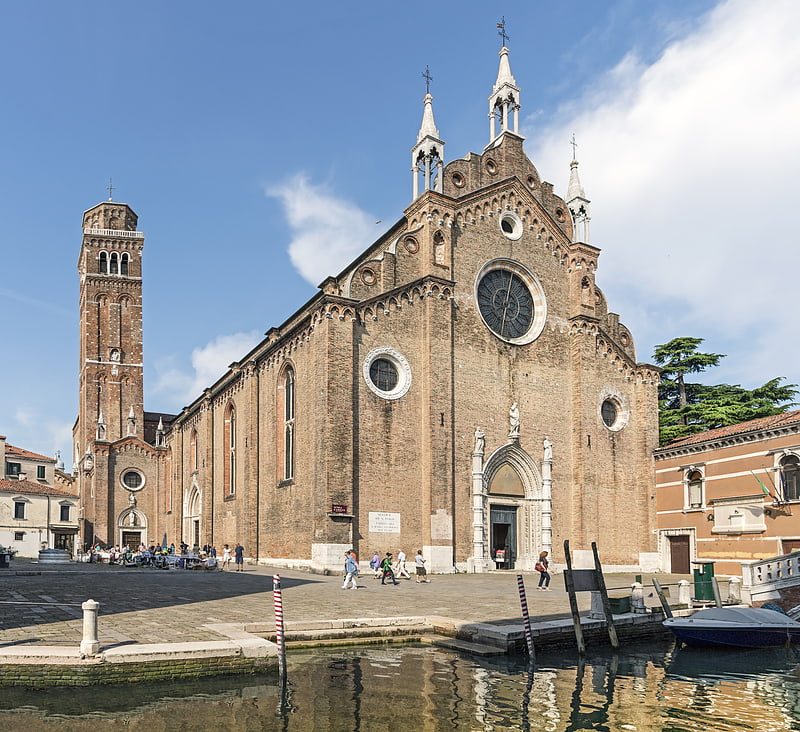
Vast 1300s church and works by Titian. The Basilica di Santa Maria Gloriosa dei Frari, usually just called the Frari, is a church located in the Campo dei Frari at the heart of the San Polo district of Venice, Italy. The largest church in the city, it has the status of a minor basilica. The church is dedicated to the Assumption of Mary.
The imposing edifice is built of brick, and is one of the city's three notable churches still mostly retaining their Venetian Gothic appearance. In common with many Franciscan churches, the exterior is rather plain, even on the front facade. The interior is notable for many very grand wall monuments to distinguished Venetians buried in the church, including a number of Doges and the painter Titian. Many of these are important works in the history of Venetian sculpture, and the many paintings include two large and important altarpieces by Titian, the Assumption of the Virgin on the high altar and the Pesaro Madonna. It also contains the only rood screen still in place in Venice.[9]
Address: Calle del Scaleter, 3072, 30125 Venezia
Gallerie dell'Accademia

A treasure trove of Venetian painting. The Gallerie dell'Accademia is a museum gallery of pre-19th-century art in Venice, northern Italy. It is housed in the Scuola della Carità on the south bank of the Grand Canal, within the sestiere of Dorsoduro. It was originally the gallery of the Accademia di Belle Arti di Venezia, the art academy of Venice, from which it became independent in 1879, and for which the Ponte dell'Accademia and the Accademia boat landing station for the vaporetto water bus are named. The two institutions remained in the same building until 2004, when the art school moved to the Ospedale degli Incurabili.[10]
Address: Campo della Carita, 1050, 30123 Venezia
Palazzo Brandolin Rota

Palazzo Brandolin Rota is a palace in Venice, Italy, located in the Dorsoduro district and overlooking the Grand Canal, between the Gallerie dell'Accademia and Palazzo Contarini Polignac.[11]
Bridge of Sighs
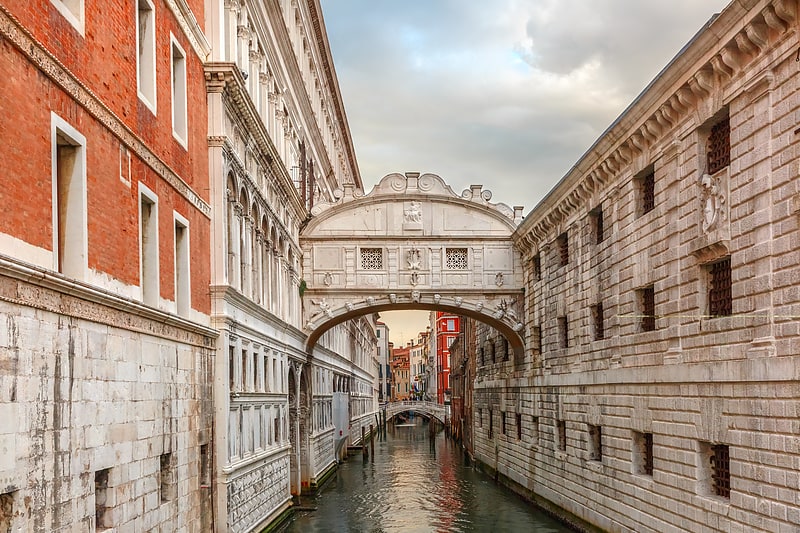
Also known as: Ponte dei Sospiri
Iconic white-stone enclosed bridge. The Bridge of Sighs is a bridge in Venice, Italy. The enclosed bridge is made of white limestone, has windows with stone bars, passes over the Rio di Palazzo, and connects the New Prison to the interrogation rooms in the Doge's Palace. It was designed by Antonio Contino, whose uncle Antonio da Ponte designed the Rialto Bridge, and it was built in 1600.[12]
Address: Piazza San Marco, 1, 30122 Venezia
Rialto Bridge

Also known as: Ponte di Rialto
Ornate footbridge over the Grand Canal. The Rialto Bridge is the oldest of the four bridges spanning the Grand Canal in Venice, Italy. Connecting the sestieri of San Marco and San Polo, it has been rebuilt several times since its first construction as a pontoon bridge in 1173, and is now a significant tourist attraction in the city.[13]
Address: Sestiere San Polo, 30125 Venezia
Palazzo Adoldo
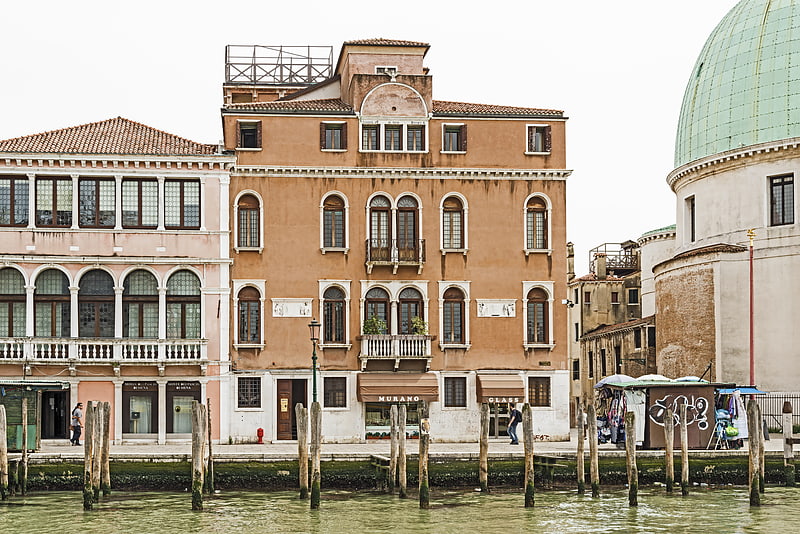
Palace. Palazzo Adoldo is a Renaissance palace in Venice, located in the Santa Croce district and overlooking the Grand Canal. On the right there is the church of San Simeon Piccolo, on the left—Palazzo Foscari Contarini.[14]
St Mark's Campanile
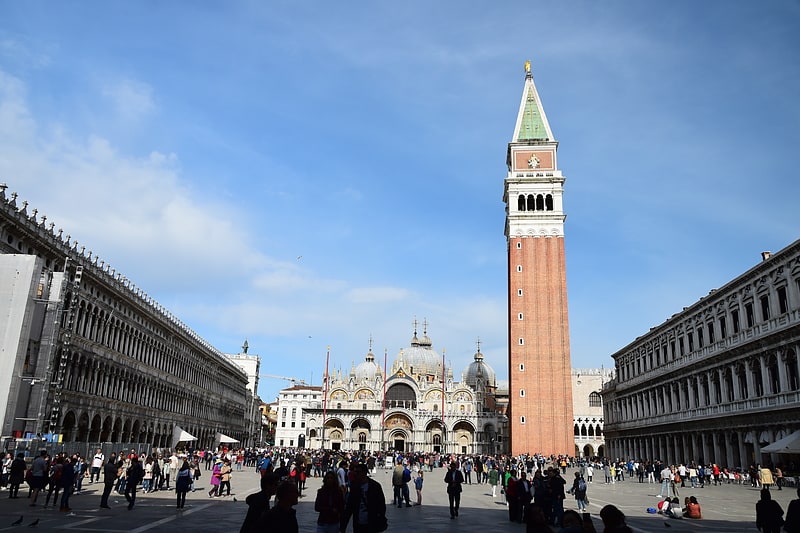
Also known as: Campanile di San Marco
Imposing landmark cathedral tower. St Mark's Campanile is the bell tower of St Mark's Basilica in Venice, Italy. The current campanile is a reconstruction completed in 1912, the previous tower having collapsed in 1902. At 98.6 metres in height, it is the tallest structure in Venice and is colloquially termed "el paròn de casa". It is one of the most recognizable symbols of the city.
Located in Saint Mark's Square near the mouth of the Grand Canal, the campanile was initially intended as a watchtower to sight approaching ships and protect the entry to the city. It also served as a landmark to guide Venetian ships safely into harbour. Construction began in the early tenth century and continued sporadically over time as the tower was slowly raised in height. A belfry and a spire were first added in the twelfth century. In the fourteenth century the spire was gilded, making the tower visible to distant ships in the Adriatic. The campanile reached its full height in 1514 when the belfry and spire were completely rebuilt on the basis of an earlier Renaissance design by Giorgio Spavento. Historically, the bells served to regulate the civic and religious life of Venice, marking the beginning, pauses, and end of the work day; the convocation of government assemblies; and public executions.
The campanile stands alone in the square, near the front of St Mark's Basilica. It has a simple form, recalling its early defensive function, the bulk of which is a square brick shaft with lesenes, 12 metres (39 ft) wide on each side and 50 metres (160 ft) tall. The belfry is topped by an attic with effigies of the Lion of St Mark and allegorical figures of Venice as Justice. The tower is capped by a pyramidal spire at the top of which there is a golden weather vane in the form of the archangel Gabriel.[15]
Address: Piazza San Marco, 30124 Venezia
Palazzo Cavalli-Franchetti
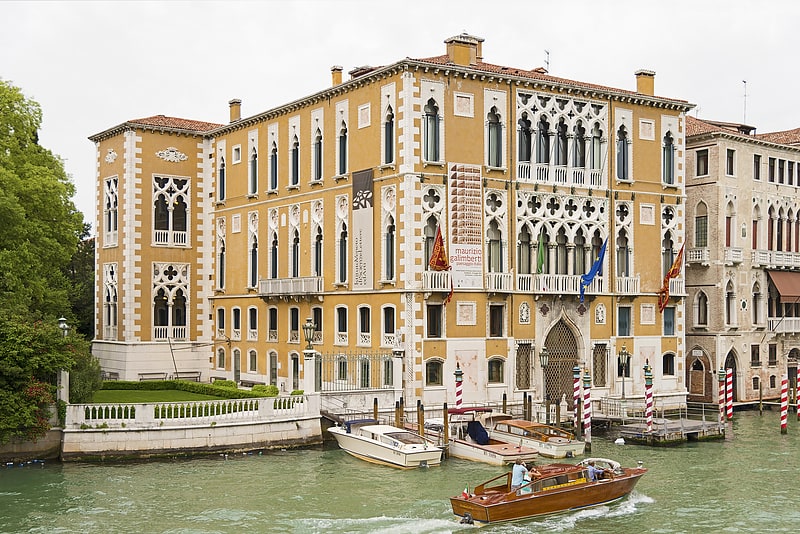
Neo-classical events and exhibition venue. Palazzo Cavalli-Franchetti is a palace in Venice, Italy, not far from the Ponte dell'Accademia and next to the Palazzo Barbaro on the Grand Canal of Venice. Since 1999 it has been the seat of the Istituto Veneto di Scienze, Lettere ed Arti and frequently houses cultural events.
The palace was erected in 1565. In the 19th century it was internally modernised and externally enriched in Venetian Gothic style, with rich window framing, by a series of grand owners. The first neo-Gothic improvements were made after 1840, when the young Archduke Frederick Ferdinand of Austria (1821–1847) reassembled the property, the Palazzo Cavalli-Gussoni, which had become divided among heirs, and embarked on a complex project intended to give a more prominent Habsburg presence along the Grand Canal, as Austria-Hungary had been awarded the territories of Venice after the Napoleonic Wars. At his premature death, unmarried, in 1847 the palazzo was bought by Henri, comte de Chambord, styled "Henri V" by Bourbon legitimists, who entrusted further restorations to Giambattista Meduna; his portrait on the balcony, with Santa Maria Della Salute in the background, is in the Ducal Palace of Modena.
In 1878 Baron Raimondo Franchetti (1829–1905), who had married Sarah Luisa de Rothschild (1834–1924), daughter of Anselm Salomon Rothschild of the Vienna Rothschilds, bought the palazzo and commissioned further works by architect Camillo Boito, who constructed the grand staircase. In September 1922 it was sold to the Istituto Federale di Credito per il Risorgimento delle Venezie by Franchetti's widow.[16]
Address: S. Marco, 2847, 30124 Venezia
Palazzo Contarini Fasan
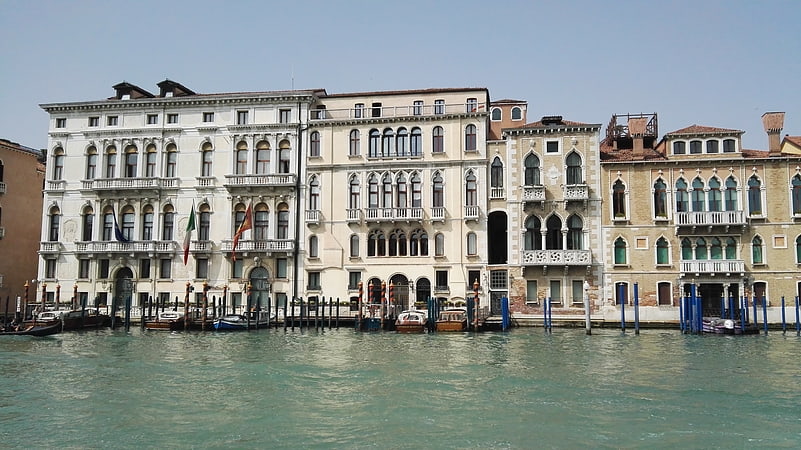
Palace. Palazzo Contarini Fasan is a small Gothic palace in Venice, Italy, located in the San Marco district and overlooking the Grand Canal. The palazzo is also called the House of Desdemona.[17]
Portrait of the Four Tetrarchs
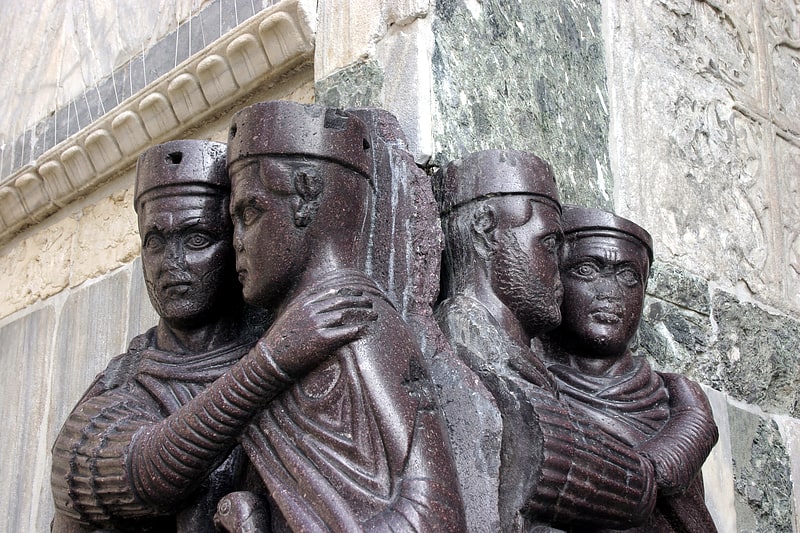
Also known as: Monumento ai Tetrarchi
Sculpture. The Portrait of the Four Tetrarchs is a porphyry sculpture group of four Roman emperors dating from around 300 AD. The sculptural group has been fixed to a corner of the façade of St Mark's Basilica in Venice, Italy since the Middle Ages. It probably formed part of the decorations of the Philadelphion in Constantinople, and was removed to Venice in 1204 or soon after.
Spolia from the Fourth Crusade, the statues were originally designed as two separate sculptures, each consisting of a pair of armoured late Roman emperors embracing one another. The paired statues stand on plinths supported by a console of the same stone, and their backs are engaged in the remains of large porphyry columns to which the statues were once attached, carved all of a piece. The columns no longer exist, and one emperor pair is missing part of the plinth and an emperor's foot, which has been found in Istanbul. One statue pair has been sliced vertically and is missing a large portion of the right-hand emperor's right side, while another vertical slice divides the two figures and has sawn through their embracing arms.
The Portrait of the Four Tetrarchs probably depicts the four rulers of the Empire instituted by Emperor Diocletian - the first Tetrarchy. He appointed as co-augustus Maximian; they chose Galerius and Constantius I as their caesares; Constantius was father to Constantine the Great. There is disagreement as to the identity of these statues and their placement, but it is suggested that the Eastern rulers form a pair and the Western rulers form the other pair, each pair consisting of the senior augustus and the junior caesar. Another possibility is that the two augusti are depicted in one pair and the two caesares in the other. A third, older theory is that they represent a dynastic group of the Constantinian dynasty.[18]
Address: Piazza San Marco, 31024 Venice
Punta della Dogana
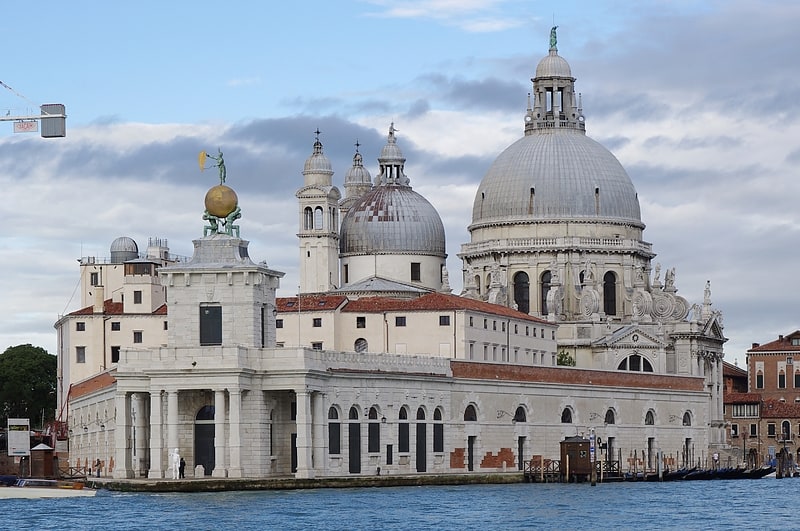
Museum in Venice, Italy. Punta della Dogana is an art museum in one of Venice's old customs buildings, the Dogana da Mar. It also refers to the triangular area of Venice where the Grand Canal meets the Giudecca Canal, and its collection of buildings: Santa Maria della Salute, the Patriarchal Seminary of Venice, and Dogana da Mar at the triangle's tip.[19]
Address: Dorsoduro, 2, 30123 Venezia
Grand Canal
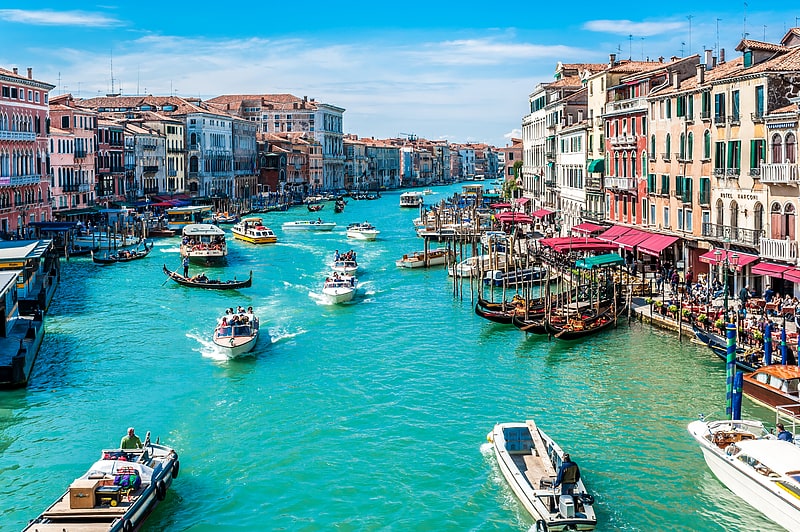
Also known as: Canal Grande
Channel in Italy. The Grand Canal is a channel in Venice, Italy. It forms one of the major water-traffic corridors in the city.
One end of the canal leads into the lagoon near the Santa Lucia railway station and the other end leads into the basin at San Marco; in between, it makes a large reverse-S shape through the central districts (sestieri) of Venice. It is 3.8 km (2.4 mi) long, and 30 to 90 m (98 to 295 ft) wide, with an average depth of 5 metres (16 feet).[20]
Address: Canal Grande, 30123 Venezia
Santi Giovanni e Paolo
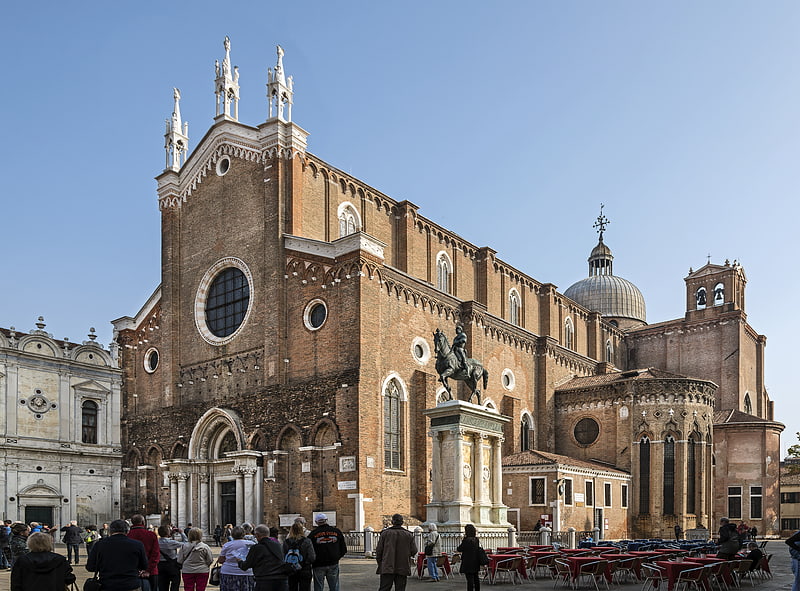
Gothic church filled with artworks. The Basilica dei Santi Giovanni e Paolo, known in Venetian as San Zanipolo, is a church in the Castello sestiere of Venice, Italy.
One of the largest churches in the city, it has the status of a minor basilica. After the 15th century the funeral services of all of Venice's doges were held here, and twenty-five doges are buried in the church.[21]
Address: Castello, 6363, 30122 Venezia
Basilica di San Pietro di Castello
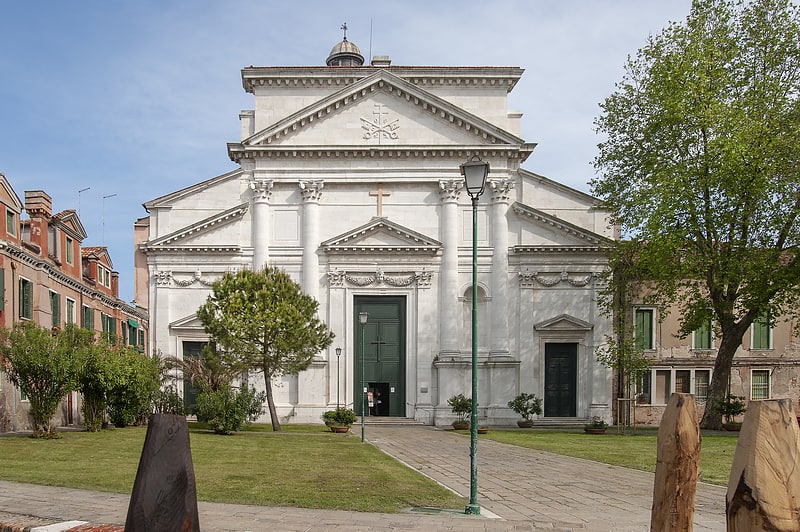
Basilica in Venice, Italy. The Basilica di San Pietro di Castello, commonly called San Pietro di Castello, is a Roman Catholic minor basilica of the Patriarch of Venice located in the Castello sestiere of the Italian city of Venice. The present building dates from the 16th century, but a church has stood on the site since at least the 7th century. From 1451 to 1807, it was the city's cathedral church, though hardly playing the usual dominant role of a cathedral, as it was overshadowed by the "state church" of San Marco, and inconveniently located. During its history the church has undergone a number of alterations and additions by some of Venice's most prominent architects. Andrea Palladio received his first commission in the city of Venice from the Patriarch Vincenzo Diedo to re-build the facade and interior of St Pietro, but Diedo's death delayed the project.
After St Mark's Basilica became Venice’s official cathedral (it had previously been the private church of the Doge), San Pietro fell into a state of disrepair. It was firebombed during the First World War and only through the efforts of conservation organisations has it been restored to its former state. Its ongoing conservation is now managed through its membership of the Chorus Association of Venetian churches.
The church is located on San Pietro di Castello (from which it derives its name), a small island off the eastern end of the main city of Venice.[22]
Address: Calle Seconda de la Fava, 70, 30122 Venezia
Santa Maria e San Donato
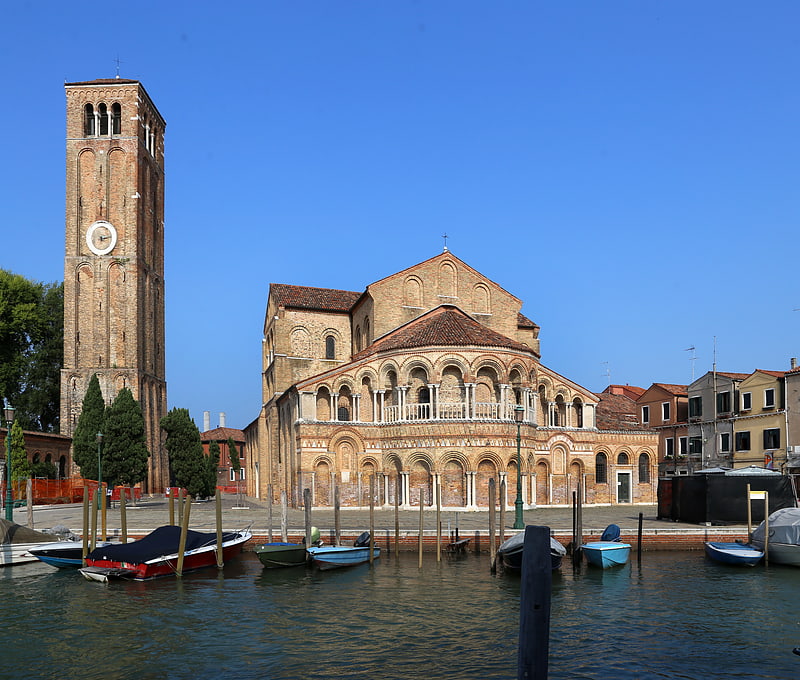
Also known as: Duomo di Murano
Historic church with storied relics. The Church of Santa Maria e San Donato is a religious edifice located in Murano, northern Italy. It is known for its twelfth century Byzantine mosaic pavement and is said to contain the relics of Saint Donatus of Arezzo as well as large bones behind the altar said to be the bones of a dragon slain by the saint.[23]
Address: Calle S. Donato, 11, 30141 Venezia
Palazzo Bellavite
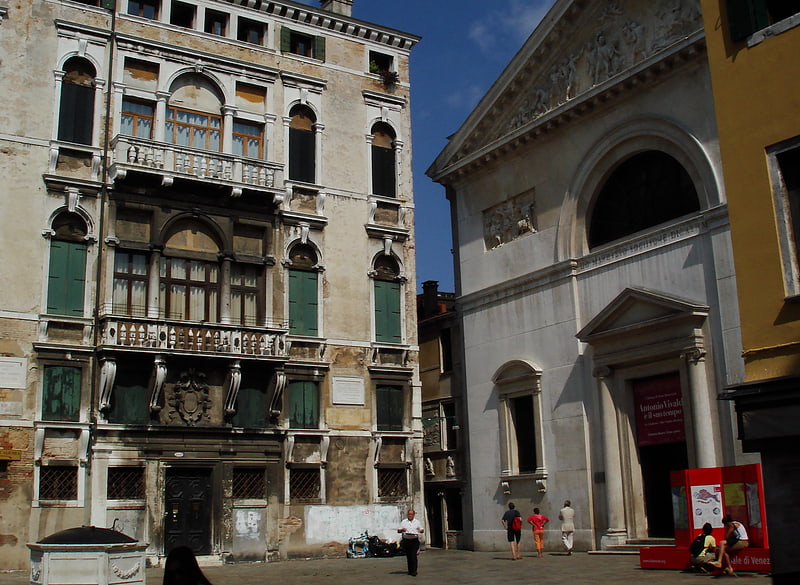
Palace in Venice, Italy. Palazzo Bellavite is a 16th-century Venetian palace, located in Campo San Maurizio, in the San Marco district. It is also known as Palazzo Bellavite Baffo, because the last member of the Baffo family lived there.[24]
Palazzo Trevisan Cappello
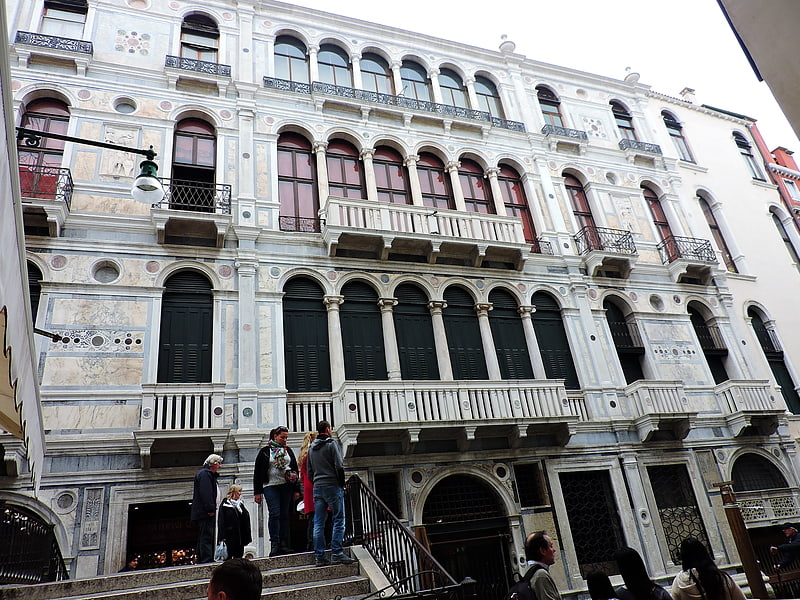
Tourist attraction in Venice, Italy. Palazzo Trevisan Cappello is a palace situated in Venice, Italy in front of Palazzo Patriarcale.[25]
Ponte dell'Accademia

Quaint wood-&-metal bridge with views. The Ponte dell'Accademia is one of only four bridges to span the Grand Canal in Venice, Italy. It crosses near the southern end of the canal, and is named for the Accademia di Belle Arti di Venezia, which from 1807 to 2004 was housed in the Scuola della Carità together with the Gallerie dell'Accademia, which is still there. The bridge links the sestieri of Dorsoduro and San Marco.
A bridge on the site was first suggested as early as 1488. The provveditore Luca Trum proposed in the council to build two bridges across the Grand Canal, one here and the other at Santa Sofia. The members of the council, however, laughed at him, and the motion was not even put to the vote. The original steel structure, designed by Alfred Neville, opened on 20 November 1854, but was demolished and replaced by a wooden bridge designed by Eugenio Miozzi and opened in 1933, despite widespread hopes for a stone bridge.
Lovers have attempted to attach padlocks to the metal hand rails of the bridge, but Venetian authorities have successfully cracked down on this.[26]
Address: Ponte dell'Accademia, 30123 Venezia
Zecca of Venice
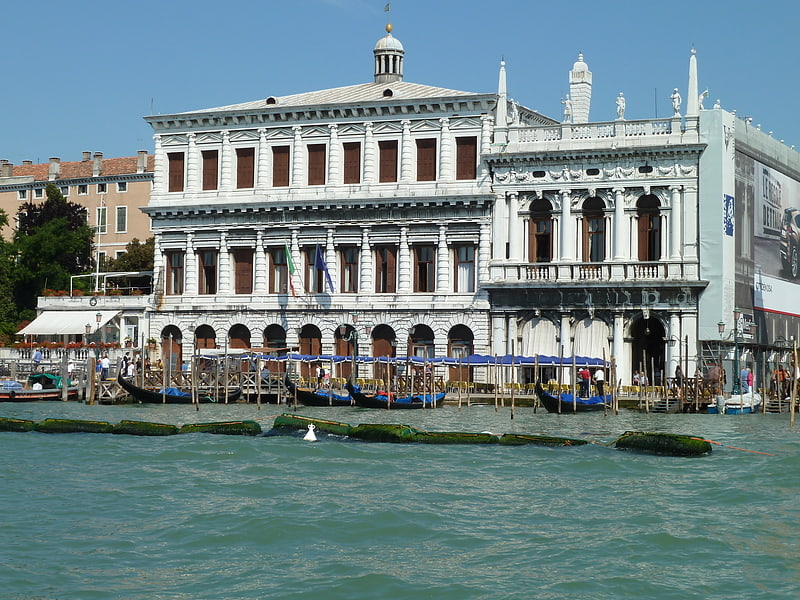
Also known as: Zecca di Venezia
Government office. The Zecca is a sixteenth-century building in Venice, Italy which once housed the mint of the Republic of Venice. Built between 1536 and 1548, the heavily rusticated stone structure, originally with only two floors, was designed by Jacopo Sansovino in place of an earlier mint specifically to ensure safety from fire and to provide adequate security for the silver and gold deposits. Giorgio Vasari considered it the finest, richest, and strongest of Sansovino's buildings.
Coin production continued after the fall of the Republic of Venice in 1797 but ceased in 1852 during the second period of Austrian domination (1814–1866). The building was subsequently adapted and served as the seat for the Chamber of Commerce from 1872 until 1900. Since 1904, it has housed the main part of the Marciana Library whose historical building, next door is now largely a museum.[27]
Palazzo Mastelli del Cammello
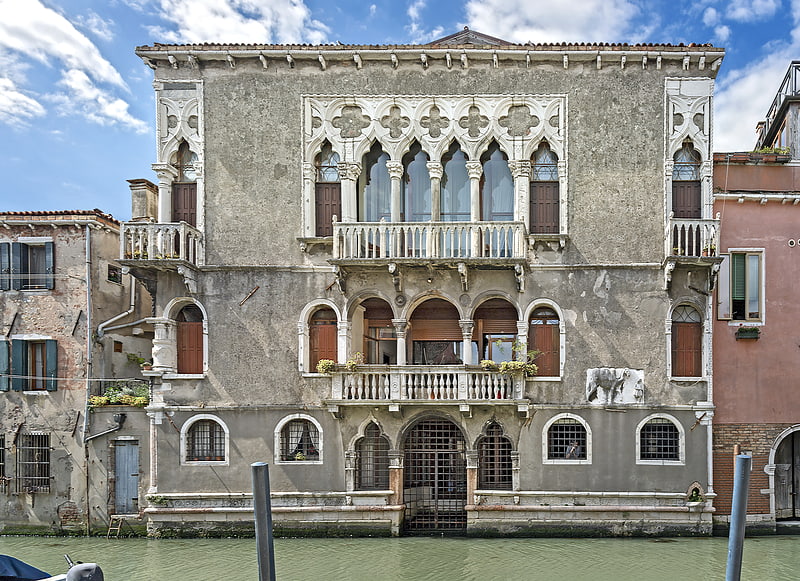
Palazzo Mastelli del Cammello is a Gothic palace in Venice, Italy. It is located in Cannaregio district, on the Campo dei Mori and the Rio Madonna dell'Orto.[28]
Columns of San Marco and San Todaro

Also known as: Colonne di San Marco e San Todaro
Historical landmark in Venice, Italy. Columns of San Marco and San Teodoro are two columns in Piazza San Marco, Venice, Italy. They comprise the Column of the Lion and the Column of San Todaro. The sculpture Lion of Venice surmounts Column of the Lion.[29]
Address: Calle Seconda de la Fava, 4312, 30122 Venezia
Palazzo Erizzo Nani Mocenigo

Palace in Venice, Italy. Palazzo Erizzo Nani Mocenigo is a palace in Venice located in the San Marco district and overlooking the Grand Canal between Palazzo Da Lezze and Palazzo Contarini delle Figure.[30]
Palazzo D'Anna Viaro Martinengo Volpi di Misurata
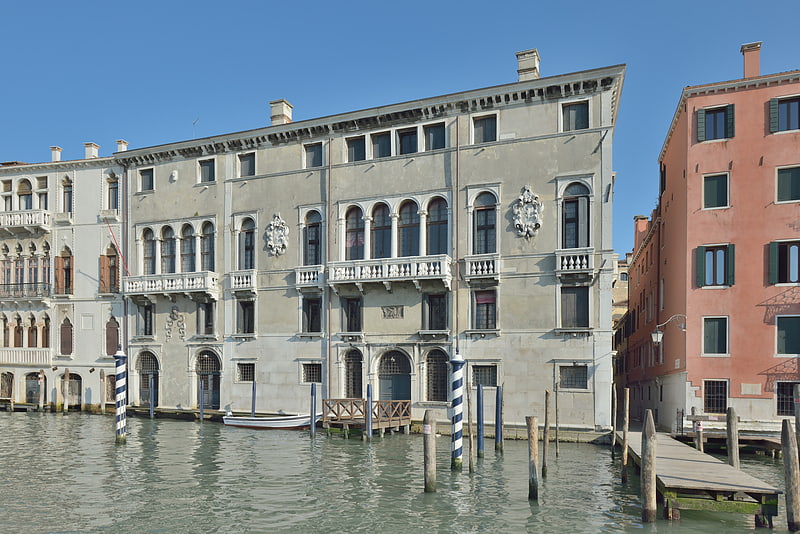
Palazzo D'Anna Viaro Martinengo Volpi di Misurata, also known as Palazzo Talenti D'Anna Volpi, is a Renaissance palace in Venice, Italy, located in the San Marco district, overlooking the left side of the Grand Canal, between Palazzo Tron and Casa Marinoni and opposite of Palazzo Donà a Sant'Aponal.[31]
Palazzo Giustinian Recanati
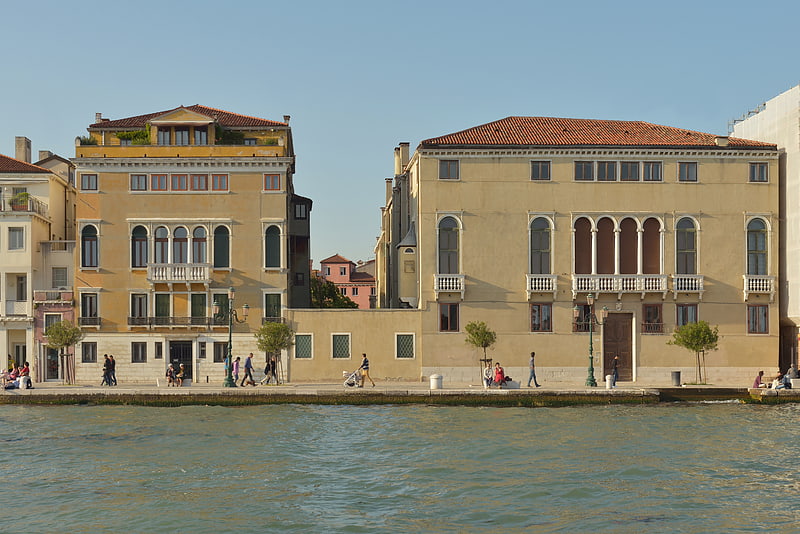
Palace. Palazzo Giustinian Recanati is a palace in Venice, Italy, located in the Dorsoduro district and overlooking the Giudecca Canal, just to the left of Palazzo Clary.[32]
Palazzi Barbaro
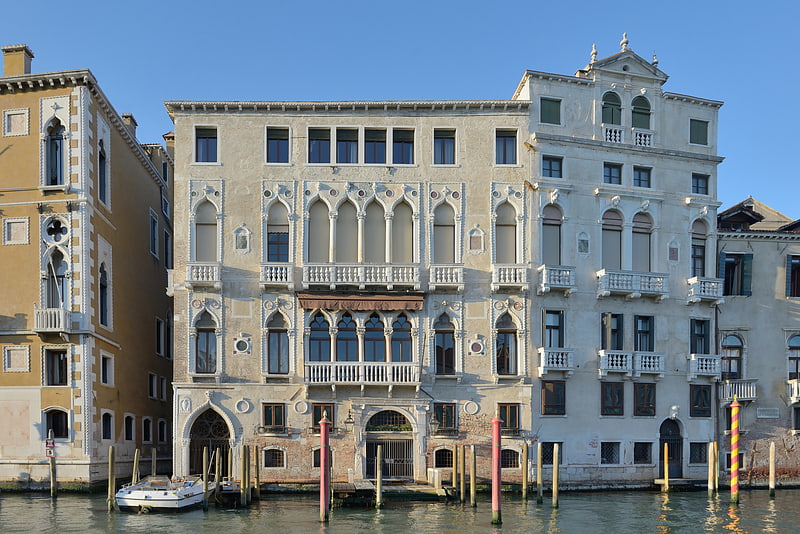
Also known as: Palazzo Barbaro a San Vidal
Palace in Venice, Italy. The Palazzi Barbaro—also known as Palazzo Barbaro, Ca' Barbaro, and Palazzo Barbaro-Curtis—are a pair of adjoining palaces, in the San Marco district of Venice, northern Italy. They were formerly one of the homes of the patrician Barbaro family. The Palazzi are located on the Grand Canal of Venice, next to the Palazzo Cavalli-Franchetti and not far from the Ponte dell'Accademia. The buildings are also known as the Palazzo Barbaro-Curtis. It is one of the least altered of the Gothic palaces of Venice.[33]
Address: San Marco 2840, Venice
Palazzo Soranzo Van Axel

Palace in Venice, Italy. Palazzo Soranzo Van Axel is a Gothic palace in Venice, Italy located in the Cannaregio district. The palace locates at the intersection of the Rio de la Panada and the Rio de Ca' Widmann.[34]
Scala Contarini del Bovolo
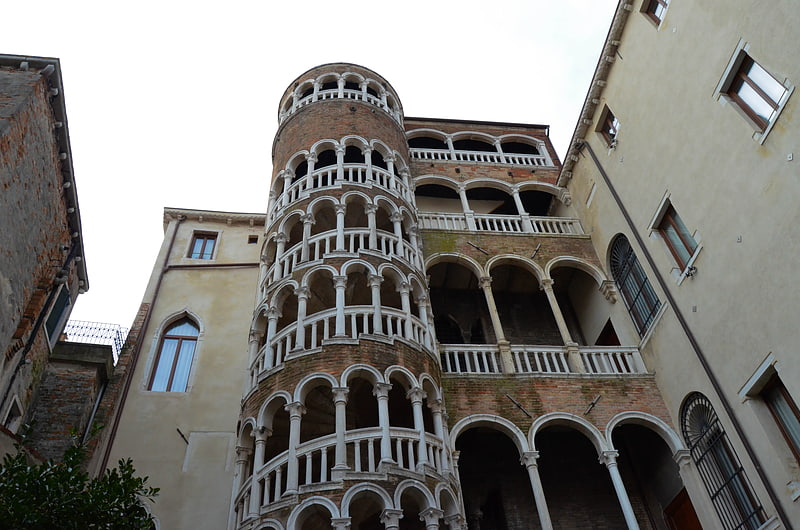
Also known as: Palazzo Contarini del Bovolo
15th-century palace and spiral staircase. The Palazzo Contarini del Bovolo is a small palazzo in Venice, Italy, best known for its external multi-arch spiral staircase known as the Scala Contarini del Bovolo.
The palazzo is located in a small, less-travelled calle (street) near Campo Manin, about half-way between Campo San Bartolo, at the foot of the Rialto, and Campo Santo Stefano.
The staircase leads to an arcade, providing an impressive view of the city roof-tops.
This palazzo has been visitable since February 2016.[35]
Address: del Bovolo, 4303, 30124 Venezia